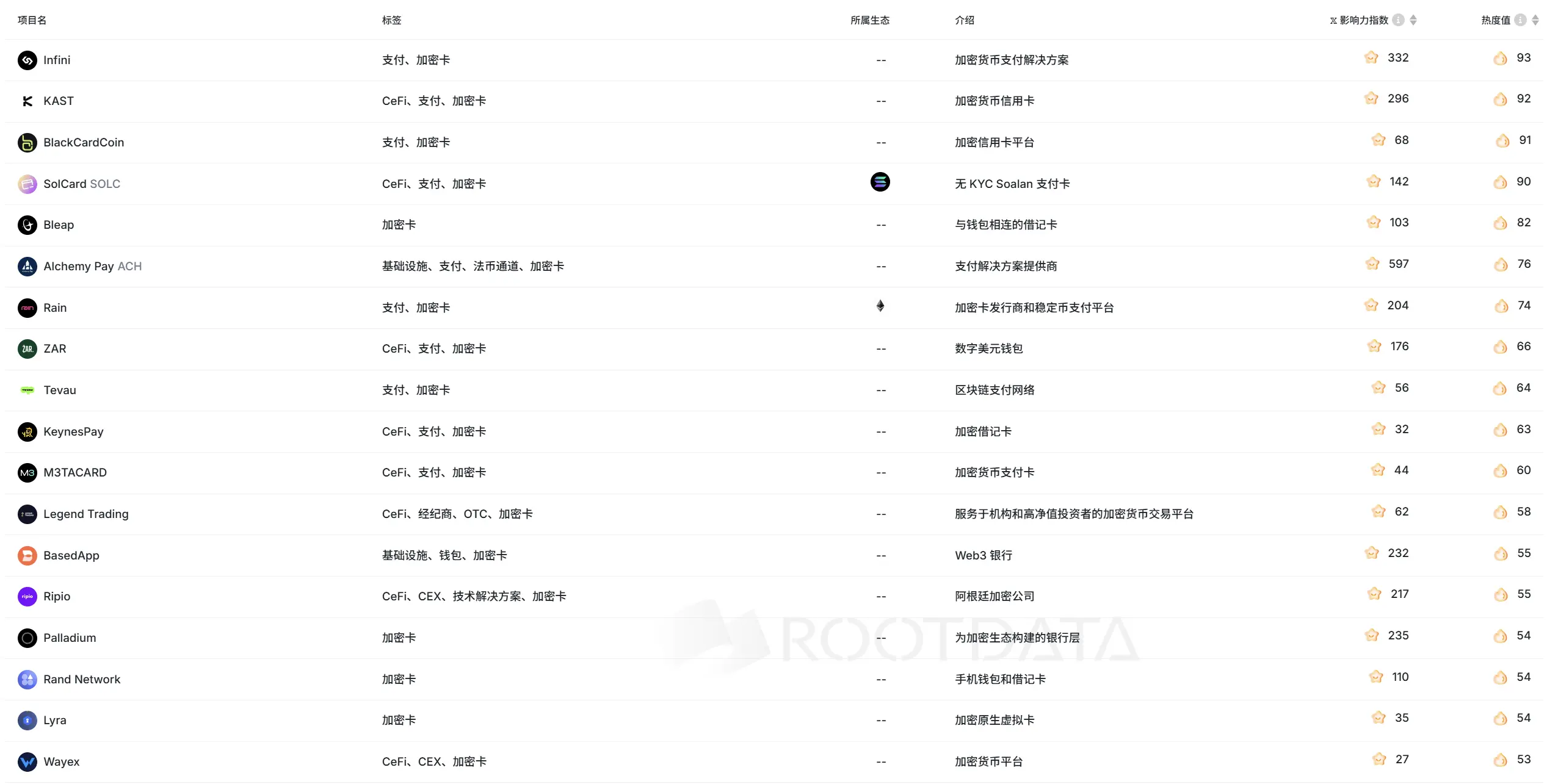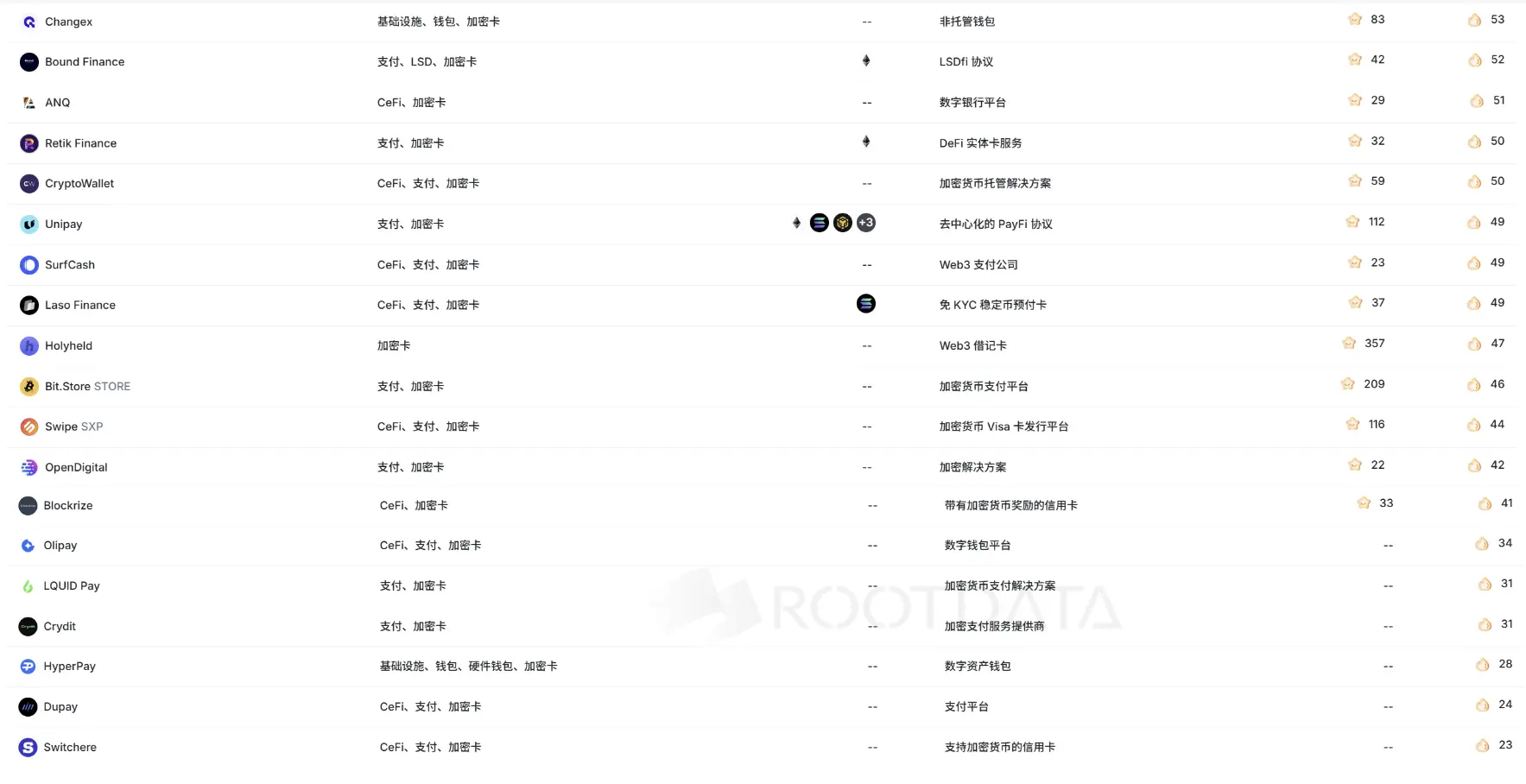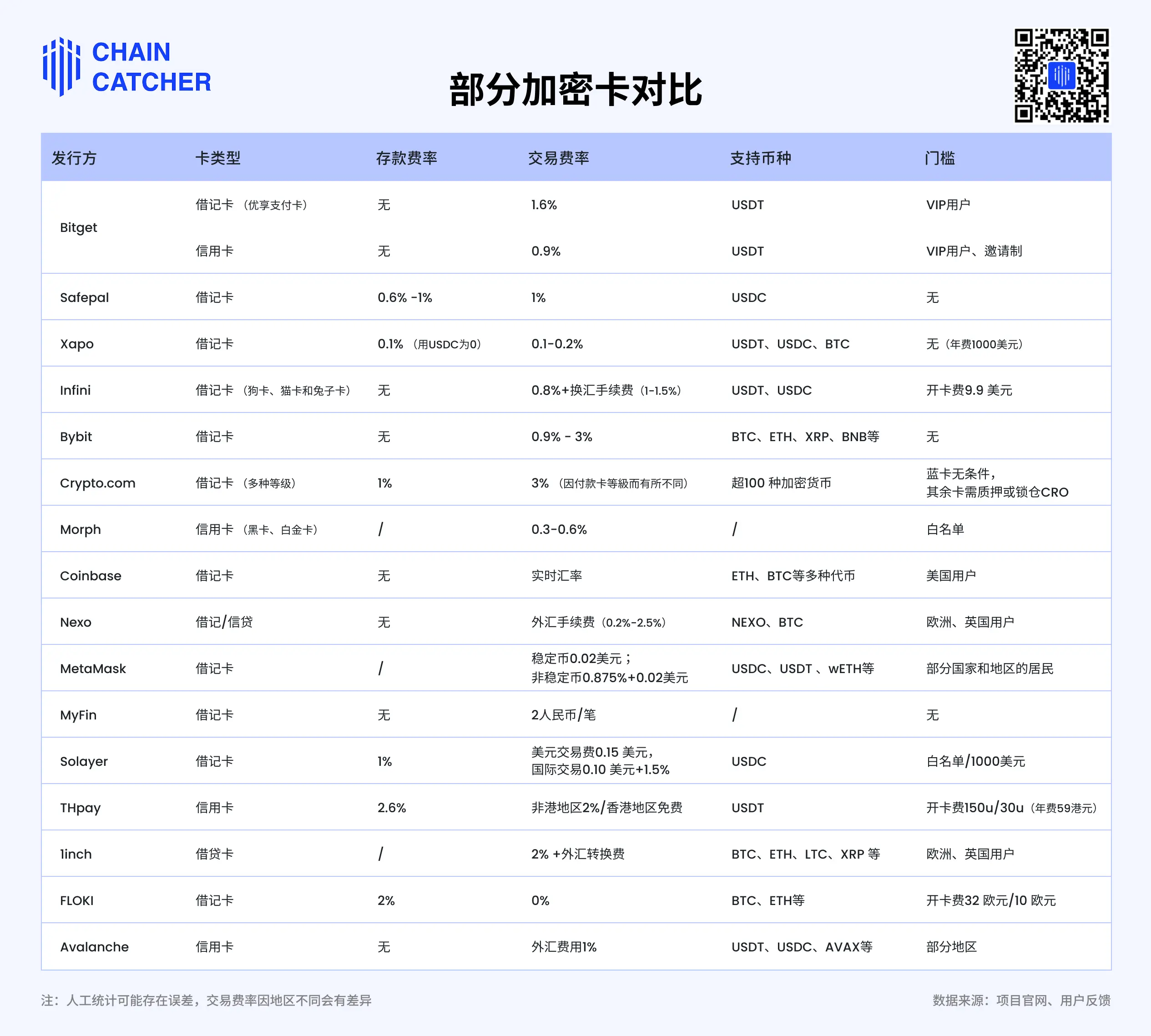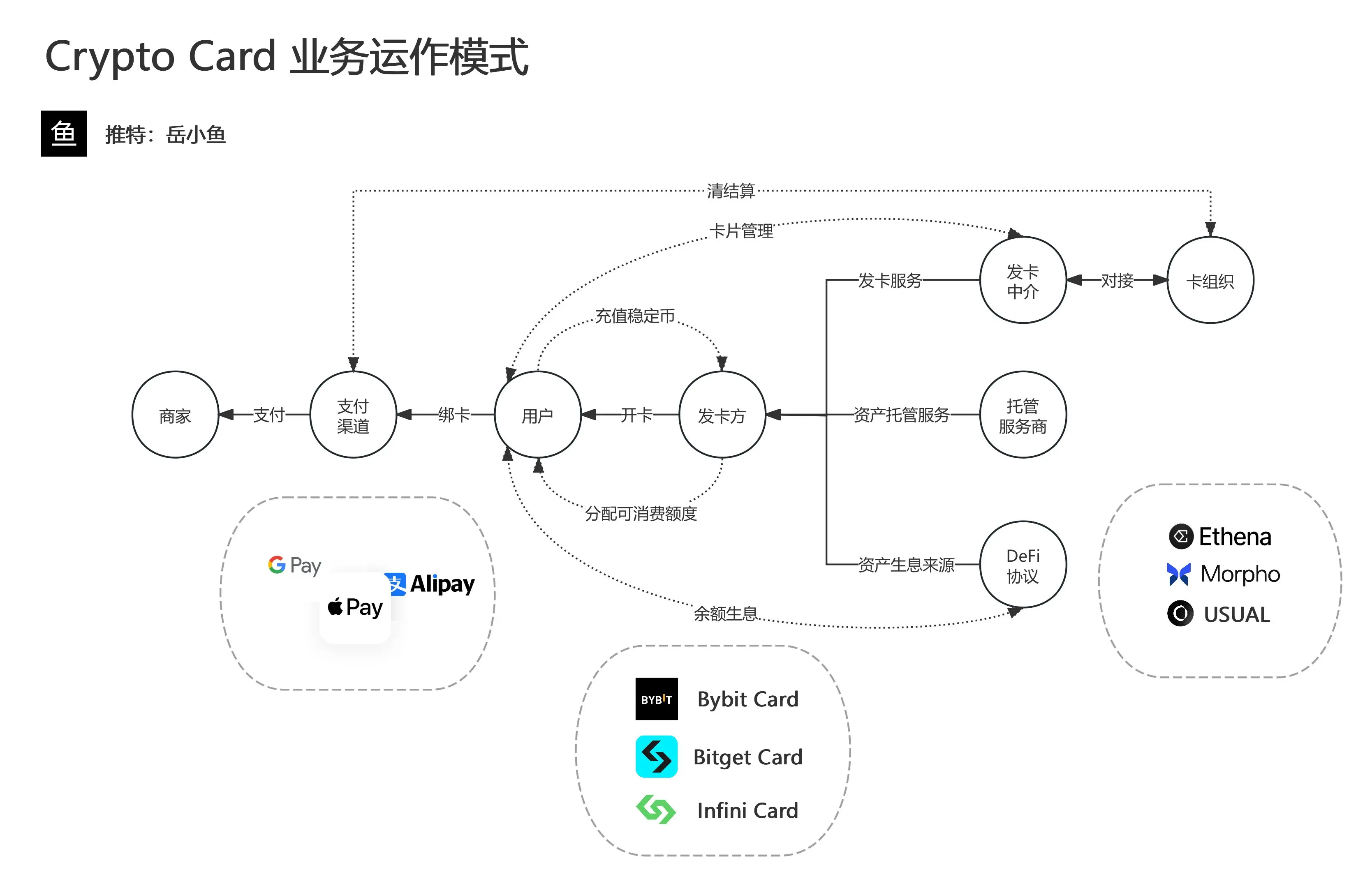Author: Fairy, ChainCatcher
Editor: TB, ChainCatcher
The cryptocurrency industry is witnessing a peculiar "physicalization" movement: card issuance.
Using USDT to order takeout, shop on JD.com, or even swipe a card at a convenience store on the street, digital assets that once only existed on screens are now quietly entering the real world through various crypto cards.
Card issuance is either the golden key to bridging Web3 and the real world or just a fleeting traffic game.
This article will dissect the driving factors, competitive landscape, and hidden risks behind this wave of crypto payment enthusiasm, clarifying this industrial leap.
The Crypto Card War Has Fully Begun
Capital is betting, and projects are racing. According to RootData, there are currently 37 projects focused on crypto card business, many of which have received significant investments from leading institutions. For example, the crypto credit card project KAST completed a $10 million seed round led jointly by Sequoia China and Sequoia India; the crypto card issuer Rain secured $24.5 million in funding led by Norwest Venture Partners, with participation from Coinbase Ventures, Circle Ventures, and others.
Overview of crypto card projects:


Image source: RootData
From "ten thousand chains" and "ten thousand exchanges," we are now evolving into the "ten thousand cards era." This competition is not just a stage for startups. More and more leading players are stepping in, with exchanges, wallets, and public chains eager to secure a place in the critical entry point for on-chain assets transitioning to offline consumption.
The market is flooded with various crypto card products, and here are some representative project comparisons:

At the same time, more cards are on the way:
- OKX will collaborate with Mastercard to launch the OKX Card
- Kraken has partnered with Mastercard to launch a crypto debit card
- MetaMask, CompoSecure, and Baanx will jointly launch a "metal card"
- ….
A single card has become a key springboard connecting Web3 and the real world, symbolizing the transition of crypto assets from "speculative goods" to "usable goods." It serves as both a bridge and a battlefield; what is brewing behind this seemingly bustling card issuance trend?
The Business of Crypto Cards
Crypto cards are essentially a type of prepaid card product. When users load stablecoins like USDT or USDC onto the card, they are not "liquidating" these assets into a card balance; instead, the issuer allocates a corresponding limit from a bank account established within the traditional card organization system, such as Visa or Mastercard.
The underlying operational mechanism is a highly centralized funding model, mainly divided into three parts: asset custody (to meet user withdrawal needs), asset interest (to generate revenue), and asset advance (to convert to fiat currency limits).

Image source: @yuexiaoyu111
In this model, the profit sources for the card issuing platform are relatively clear: on one hand, there are card fees and exchange fees; on the other hand, there are operational revenues generated from the platform's retained funds. However, as seen in the previous comparison of crypto cards, the competition for card fees and transaction fees has already "opened the book," with almost all platforms lowering fee thresholds to attract users, even adding various "sweeteners"—airdrops, cashback, discounts.
Therefore, crypto cards are essentially a low-margin business; platforms can only achieve sustainable profits when they realize large-scale transaction volumes and fund retention. For platforms, the essence of this business is actually the competition for users' "payment entry." The real contest lies not only in brand building and channel occupation but also in a game surrounding user traffic.
Moreover, exchanges and wallets have a natural advantage in expanding this business, as it not only helps enrich their business matrix but also enhances market potential and development ceilings.
Fever and Hidden Reefs
This wave of "card issuance" has brought many opportunities, but it also hides numerous challenges and risks. There are various interpretations of the value and issues surrounding crypto cards within the industry.
From a regional perspective, the acceptance of crypto cards varies across different markets. Researcher @sjbtc9 pointed out that in Australia, Europe, North America, and Latin America, crypto cards are popular because they can avoid high inflation and compensate for local financial service deficiencies. In contrast, regions like Singapore, with more robust compliance systems, have users with smooth withdrawal channels, leading to relatively low demand for crypto cards. In the domestic market, crypto cards are often used for payments for overseas services like ChatGPT subscriptions.
Additionally, crypto cards also play the role of "substituting intermediaries" in certain areas. For instance, in the context of high-risk OTC trading, crypto cards provide a more direct and stable funding entry and exit.
However, hidden reefs are also emerging. Compliance and risk control are challenges that crypto cards cannot avoid. Crypto KOL Yue Xiaoyu once shared that OneKey Card quickly gained popularity due to its excellent product experience but had to suspend KYC for mainland users and completely shut down its card business under compliance pressure. This not only exposes the high uncertainty under policy regulation but also reflects the difficulty of sustaining the expansion of crypto card businesses in the face of sluggish user growth.
As community user @agintender stated, beneath the surface of crypto cards lies a "risk control hell": how to deal with frozen funds, theft, and claims; how to cooperate with investigations and manage user fund flows; how to establish reasonable customer profiling and storytelling capabilities are all core issues that crypto cards must address.
Security risks are also a significant hidden danger that cannot be ignored. In February of this year, card issuer Infini suffered an attack, resulting in losses exceeding $49 million. Crypto KOL @_FORAB revealed that after the incident, several U card service providers entered maintenance mode and even suspended card issuance. This incident highlights that security and risk prevention are key factors for the sustainable development of crypto cards.

The wave of card issuance is not just a competition among cards; it is also a struggle for passage rights between Web3 and the real world. Each metal card gleams not only with a brand logo but also with the sound of the crypto economy knocking on the door of mainstream society.
Whether it succeeds or fails, who will stand out will be revealed in time.
免责声明:本文章仅代表作者个人观点,不代表本平台的立场和观点。本文章仅供信息分享,不构成对任何人的任何投资建议。用户与作者之间的任何争议,与本平台无关。如网页中刊载的文章或图片涉及侵权,请提供相关的权利证明和身份证明发送邮件到support@aicoin.com,本平台相关工作人员将会进行核查。



